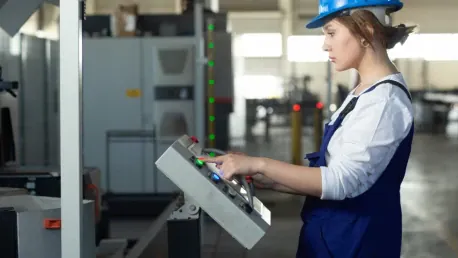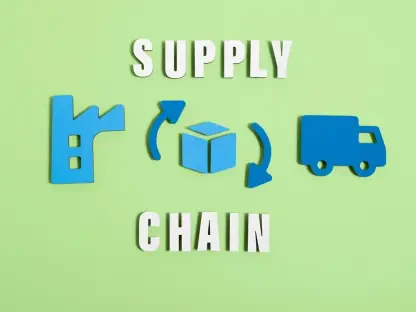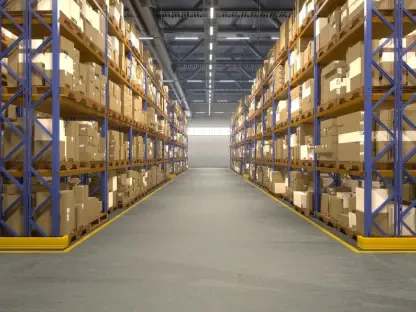The Logistics Automation Market is on the brink of a significant transformation, with projections indicating a robust Compound Annual Growth Rate (CAGR) of 13.3% from 2025 to 2032. This anticipated growth underscores the sector’s relentless technological advancements and the increasing global adoption of automation solutions in logistics processes. A recent research report by Fortune Business Insights provides a comprehensive analysis of the key factors influencing this market, including regional growth, market segmentation, revenue status of top players, and the driving forces behind this surge.
Technological Advancements Driving Efficiency
The adoption of advanced technologies such as Artificial Intelligence (AI), the Internet of Things (IoT), and robotics has revolutionized logistics operations. These technologies enhance efficiency, accuracy, and speed, facilitating real-time tracking, optimal route planning, automated storage and retrieval systems, and predictive maintenance. The integration of AI and IoT in logistics automation allows for smarter decision-making and improved operational workflows, significantly reducing human error and operational costs.
Robotics, in particular, has played a pivotal role in transforming warehouse operations. Automated Guided Vehicles (AGVs) and robotic arms are now commonplace in modern warehouses, handling tasks ranging from picking and packing to sorting and transporting goods. These advancements not only streamline operations but also ensure higher productivity and safety standards. As these technologies continue to evolve, their capabilities will only expand, further solidifying their role as essential components in the logistics automation landscape.
Additionally, advanced software solutions have become instrumental in logistics automation. Machine learning algorithms are being employed to predict demand patterns, optimize inventory management, and enhance supply chain visibility. With the increased use of data analytics, logistics companies can gain deeper insights into their operations, enabling them to make more informed and strategic decisions. These advancements collectively contribute to a more efficient, reliable, and responsive logistics system.
E-commerce Boom Fueling Demand
The rapid expansion of the e-commerce sector has significantly increased the demand for efficient logistics and supply chain solutions. E-commerce companies are under constant pressure to fulfill orders quickly and accurately, manage inventory efficiently, and ensure timely last-mile delivery. This has driven many e-commerce giants to invest heavily in logistics automation to meet consumer expectations and maintain a competitive edge.
Automation solutions such as automated sortation systems and warehouse management software have become essential tools for e-commerce businesses. These technologies enable seamless order processing, real-time inventory tracking, and efficient distribution, ensuring that customers receive their orders promptly and accurately. As e-commerce continues to grow, the demand for advanced logistics automation solutions is expected to rise correspondingly. This trend is further amplified by consumer preferences shifting towards online shopping, making efficient logistics management a critical success factor for e-commerce companies.
Moreover, the increasing popularity of same-day and next-day delivery services has heightened the need for automated logistics operations. Features like automated packaging and labeling systems are now indispensable for e-commerce fulfillment centers, allowing them to process higher volumes of orders at faster rates. This ensures that e-commerce businesses can remain competitive in an ever-demanding market, ultimately driving the widespread adoption of logistics automation technologies.
Regional Growth and Market Dynamics
Different regions are experiencing varying degrees of growth in logistics automation. North America and Europe have been early adopters of automation technologies, benefiting from well-established infrastructure and a high level of technological awareness. However, the Asia-Pacific region is now emerging as a significant market due to rapid industrialization, urbanization, and the growth of e-commerce activities.
Countries like China, India, and Japan are witnessing substantial investments in logistics automation, driven by the need to enhance supply chain efficiency and meet the demands of a growing consumer base. The regional analysis in the report highlights the sales figures, revenue, and growth rates of individual regions, offering valuable insights into the regional dynamics of the market. These insights help businesses identify lucrative opportunities and tailor their strategies to cater to the unique demands and challenges of each region.
Furthermore, government initiatives and policies that promote technological adoption are playing a crucial role in fostering regional growth. Various governments are investing in infrastructure development and offering incentives to encourage businesses to adopt advanced logistics automation solutions. Such initiatives are particularly prevalent in the Asia-Pacific region, where rapid economic growth and increasing consumer demand are driving the need for more efficient and automated logistics systems.
Cost Optimization and Efficiency
Businesses are continuously seeking cost optimization strategies to stay competitive in the market. Automation solutions help reduce labor costs, minimize errors, and increase productivity, enabling companies to achieve better profit margins and improved service levels. By automating repetitive and labor-intensive tasks, businesses can allocate their human resources to more strategic and value-added activities.
Moreover, automation technologies facilitate better resource management and utilization, leading to significant cost savings. For instance, automated storage and retrieval systems (AS/RS) optimize warehouse space and improve inventory accuracy, reducing the need for excess inventory and associated holding costs. These efficiencies contribute to a more streamlined and cost-effective supply chain, ultimately enhancing the overall profitability of businesses. Automated systems also allow for more effective handling and distribution of goods, reducing lead times and improving customer satisfaction.
In addition to direct cost savings, the use of automation in logistics operations minimizes the risk of human error, which can often lead to costly mistakes. Automated systems ensure precise and consistent execution of tasks, resulting in higher accuracy and reliability. This degree of precision not only enhances operational efficiency but also boosts customer trust and loyalty, as businesses are able to deliver on their promises with greater consistency.
Impact of COVID-19 on Logistics Automation
The COVID-19 pandemic significantly disrupted global supply chains, emphasizing the need for resilient and automated logistics solutions. The pandemic acted as a catalyst, accelerating the adoption of automation technologies to mitigate the impact of labor shortages and ensure continuous operations during lockdowns and restrictions. Companies that had already invested in automation were better equipped to navigate the challenges posed by the pandemic, while others ramped up their investments to ensure resilience against future disruptions.
The need for contactless operations, reduced dependency on manual labor, and efficient supply chain management became more apparent during the pandemic. Automation technologies played a crucial role in maintaining business continuity, enabling companies to adapt to the new normal and meet the changing demands of consumers. As businesses continue to grapple with the long-term effects of the pandemic, the value of automation in logistics will only become more pronounced.
Furthermore, the pandemic underscored the importance of agility and flexibility in supply chain operations. Automated systems allow businesses to quickly adjust to unexpected changes in demand, manage supply chain disruptions, and maintain high levels of service even under challenging conditions. This ability to swiftly adapt and respond to unforeseen circumstances has been a significant driver of the increased adoption of logistics automation technologies during and after the pandemic.
Competitive Landscape and Key Players
The Logistics Automation Market is highly competitive, with several key players contributing to its dynamic nature. Prominent companies such as Daifuku Co., Ltd., Dematic Corporation, Murata Machinery, Ltd., WiseTech Global Limited, KNAPP AG, Honeywell Intelligrated, Inc., Swisslog Holding AG, and TGW Logistics Group GmbH are actively engaged in developing and implementing innovative automation solutions to enhance logistics operations.
These companies are investing heavily in research and development to introduce advanced automation technologies that cater to the evolving needs of the logistics industry. Strategic partnerships and collaborations between companies are also anticipated to enhance market penetration and expand their customer base, leveraging each other’s strengths and expertise to deliver comprehensive automation solutions. This collaborative approach not only fosters innovation but also accelerates the development and deployment of cutting-edge technologies in the logistics sector.
In addition to partnerships, key players in the market are also focusing on acquiring smaller companies and startups that offer unique and innovative automation solutions. These acquisitions enable larger corporations to diversify their product portfolios, broaden their technological capabilities, and strengthen their market presence. By integrating new technologies and expertise, established firms can stay ahead of industry trends and maintain their competitive edge in the rapidly evolving logistics automation market.
Market Segmentation and Strategic Insights
The Logistics Automation Market is on the cusp of a substantial transformation, with expectations of a strong Compound Annual Growth Rate (CAGR) of 13.3% from 2025 to 2032. This projected growth highlights the sector’s continuous technological advancements and the rising global adoption of automation solutions in logistics operations. A recent detailed research report by Fortune Business Insights delves into the crucial factors influencing this market. It covers regional growth trends, market segmentation, and revenue standings of top market players. Additionally, the report identifies the driving forces behind this surge, emphasizing how innovative automation technologies are reshaping logistics processes. This anticipated growth marks a significant shift in the logistics industry’s landscape, reinforcing the importance of embracing automation to enhance efficiency, reduce operational costs, and improve overall productivity. Investors and stakeholders should pay close attention to these trends, as they promise to unlock new opportunities and reshape the future of logistics.









